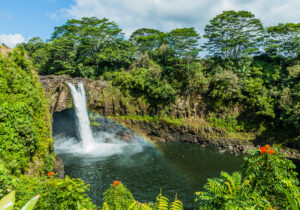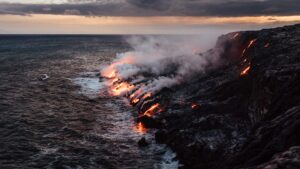Kilauea Eruption
September-November 2021 Eruption
John Derrick, Publisher for Hawaiʻi guide gives an update (as of 11/19) of the Kilauea eruption. We have 4 different tours that explore the Volcano in comfort.
Kilauea volcano, on the Big Island of Hawaiʻi, is currently erupting at its summit, creating small fountains and thick plumes of smoke – flooding the floor of Halemaumau Crater with fresh lava flows.
The latest eruption within Halemaumau Crater started about 20 minutes after 3 p.m. Wednesday – September 29, 2021; currently, all lava is confined within the crater. The eruption came after a day of increased earthquake activity at the volcano and summit.
The eruption is currently confined to Halemaumau crater, within Hawaiʻi Volcanoes National Park. HVO does not see any indication of activity migrating elsewhere on Kilauea volcano and expects the eruption to remain confined to the summit region.
The last eruption at Kilauea ended in May (see below) after an explosive beginning five months earlier in December 2020. It is unclear how long the current eruption will continue. Kilauea summit eruptions over the past 200 years have lasted from less than a day to more than a decade. This ongoing eruption is similar to the most recent Kilauea eruption, which was also confined to Halemaʻumaʻu crater and generated a lava lake; the most recent eruption lasted approximately five months, from December 2020 to May 2021.
If you’re currently on the Big Island, this is a great time to witness the glow of an eruption up close on the summit; as usual, nighttime viewing is best. Dress accordingly as it’s 4,000+ ft in elevation at the summit of Kilauea and it can get fairly chilly after dark.
Current Activity Summary*: Kīlauea volcano is erupting from a single vent in the western wall of Halemaʻumaʻu crater. As of this morning, November 18, 2021, lava is erupting at the summit. All lava activity is confined within Halemaʻumaʻu crater in Hawai‘i Volcanoes National Park. Seismic activity and volcanic gas emission rates remain elevated.
Halema’uma’u Lava Lake Observations*: Lava continues to erupt from a single vent in the western wall of Halemaʻumaʻu crater, while the eastern edge of the lake continues to advance onto the lowest of the exposed down-dropped caldera floor blocks. The western end of the lake showed a maximum elevation of approximately 803.5 meters (2637 ft) above sea level by HVO’s permanent laser rangefinder this morning, and a total increase of about 60 meters (197 ft) since lava emerged on September 29. Webcams show spatter and ponded lava within the west vent, an area of active lava at the surface of the lava lake, and sporadic oozes of lava along the cooler outer lake margins. The total erupted volume since the beginning of the eruption was estimated to be about 30 million cubic meters (7.8 billion gallons) on November 16.
Potential Hazards: This new eruption at Kilauea’s summit is occurring within a closed area of Hawai’i Volcanoes National Park. Therefore, high levels of volcanic gas are the primary hazard of concern, as this hazard can have far-reaching effects downwind. Large amounts of volcanic gas—primarily water vapor (H2O), carbon dioxide (CO2), and sulfur dioxide (SO2)—are continuously released during the eruptions of Kilauea Volcano. As SO2 is released from the summit, it reacts in the atmosphere to create the visible haze known as vog (volcanic smog) that has been observed downwind of Kīlauea.




